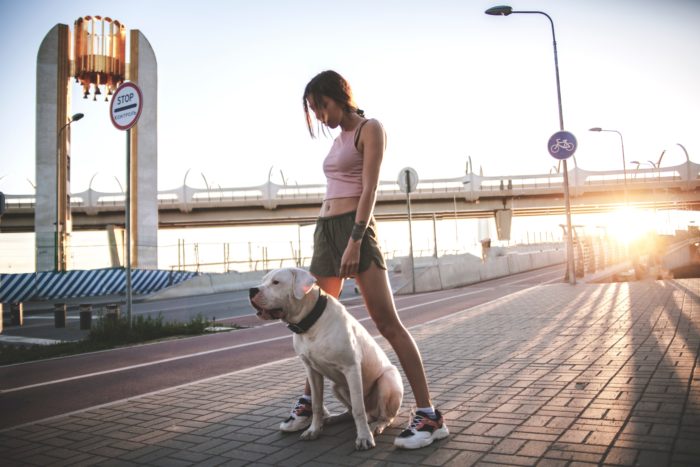Our pets always have a way of making the start of each week even more enjoyable. Today, Kimberly Artley informs us about how we can improve the human-canine relationship we have with our pooches through the walk. It’s such an important part of America‘s day and my day, too—enjoy!
The Human-Canine Relationship
One of the most important yet challenging aspects of the human-canine dynamic is, in fact, the walk. This one seemingly simple activity provides one of the most honest and authentic pieces of information we can garner regarding human and dog interactions.
What goes down outside closed doors serves as a reflection for what goes on inside and behind them.
If there are no rules or boundaries in the home, we’ll see it reflected in the walk. If there’s little to no trust or respect between human and dog, we’ll see it reflected in the walk. Similarly, if there’s no structure or order in daily life and “the way of things,” we’ll see it reflected in the walk.

We Reflect What We Feel
We reflect the relationship we have with ourselves and what we feel we’re capable of during the walk. Our dogs are also reflecting the relationship they have with us and what they feel we’re capable of. The walk communicates, establishes and reinforces so much.
Two mantras I always encourage clients to adopt are:
- I’ve got this
- I’ve got your back.
The first mantra works on confidence in ourselves, while the second works on the confidence our dogs should have in us.
Nailing The Walk
When dogs walk with a human who they feel “has their stuff together”, has their back and can handle whatever may come their way, they carry themselves weightlessly with calm, confidence and ease.
If the human neither leads nor guides with some sense of confidence and control, this creates a lack of security for the dog; and may even cause them to step up their game and walk in a “hyper-alert” mode, considering everyone and everything a threat.
Nailing the walk has far more to do with us than our canine companions. If the walk is anything but enjoyable, here are some helpful tips to help turn it all around:
The Walk: Fundamentals
The Walk Begins Before We Step Outside the Door
What goes on inside the door sets the tone for what will go down outside the door.
If an escalated, frantic, excited state of mind is constantly created–for example, asking our dogs, “Do you want to go for a walk?” with the vocal inflection going up, high pitch and tone, and the dog gets rewarded for practicing excitement through getting leashed up and moving through the door–we’re conditioning overly-aroused, excited states of mind. Poor choices and reactions can occur here.
N.B. There’s a big difference between a “response” and a “reaction”; a response comes from a grounded, calm state of mind, while a reaction is just the opposite and is an offshoot of an escalated, excited, overly-aroused state of mind. The body always follows what the mind is doing, so learning how to condition and better manage and control state of mind is *huge*.
Move to the Door
No words should be spoken here except for clear, simple directives. Whether the dog is sitting or standing doesn’t matter to me. What I expect, and what I want to reinforce, is a calm state of mind (note: a sitting dog doesn’t necessarily denote a calm dog).
Leash up then move through the door only when the dog is calm, which may take some time in the beginning. Then reward this by allowing the dog to move through the door with you.
Pick a Side
For many, having a dog walk on the left side is most comfortable, but do what works best for you. Keep in mind, we’re supposed to be on a walk with our dog not by our dog or vice versa.
This shared and mutually-beneficial activity creates one of the best ways to solidify the relationship and strengthen the bond. A dog out in front controls the walk, dictating pace, speed, and direction. This also allows the dog to make up the rules and puts us in the follower position, as well.
Keeping the dog by our side and holding them accountable for this will speak volumes. It also allows us to better influence, manage and control choices, state of mind, and behavior.
Choose the Best Toolset to Suit Your Needs
Every dog is different, as is every human. If our dog isn’t walking like an absolute dream beside us, a few helpful tools can assist as the relationship develops and strengthens.
Certain types of collars act as effective aids to communication and state of mind managers. When considering a certain type of training collar, please seek education and guidance on how to properly fit and use the collar.
Keep a Long, Relaxed Arm with a Short, Loose Leash
There’s a language to the leash, which needs to be established first and foremost. The leash is a direct line of communication and, when used appropriately, is a game-changer in how effective we are with our dog.
All too often, leashes are used to restrict, restrain or force direction and compliance, tension and tightness a common thing. Tension begets tension and is usually the byproduct of anything but calm and peace on our part. We say more than we realize through the leash. Remember, it serves as a direct line of communication so when we communicate tension, it’s tension we’ll get in return. We get what we give.
Press Your Shoulders Down and Back, Lift your Chin up, and Walk Confidently Forward
Our body language and posture speaks volumes. By pressing our shoulders down and back while lifting our chin, we’re owning our space- not shrinking in it.
Try doing this right now and feel the difference it makes!
Don’t Hesitate, Motivate
Do so through forward motion and quick choice-making. Keeping things moving forward and fluid imparts a certain message, as does when we stop, hesitate or pause–especially in moments layered with distraction or cause for concern.
Hesitation usually happens when we’re trying to figure out what to do. However, this can also convey doubt and uncertainty to our dog. Motivate through quick choice-making while moving forward and through sticky situations with confidence.
Breathe Long, Hard and Deep
Breath is our barometer and indicates how we feel each second. Breath also serves as a natural reset button for the internal nervous system. If you’re out on a walk and a hairy situation arises, simply breathe long, hard and deep while confidently moving your way through or around it.
Continue Moving Forward
In sticky scenarios, many people will put their dog in a “sit,” cover their eyes, dance around in front of them to block their view, and employ other–albeit quite entertaining–moves. Putting a reactionary dog in a stationary position with an oncoming trigger only causes them to hyper-fixate and hyper-focus on said trigger. Thus, intensifying and amplifying any reaction.
Keep things fluid and moving, leading your dog through or around the situation calmly and confidently. You’ve got this!
Envision and Feed What You Want to Happen Instead of What You Fear Will Happen
What we continue to expect will surely come to pass. When we focus more on how we want things to go as opposed to how we don’t want or fear they will go, the odds stack in our favor for a most positive outcome. Envision what you want to happen and focus on this with all your might!
Exercise
Exercise is one of the most important aspects of a dog’s health, as well as our own. In nature, wild canines roam a reported 40 – 70 miles each day! This instinctual need must be fulfilled by us on a daily basis.
Sadly, many urbanite dogs receive an incredibly small fraction of this. Aside from their overall health, this also greatly impacts their state of mind and behavior.
Most dogs need more than a leash walk. It’s important to match the duration and intensity of a dog’s exercise with their individual energy level. If short on time, increase the intensity of the activity. However, if you’ve got the time, opt for duration or a mix of both. Perhaps you walk a block, then jog a block, walk a block and jog a block.
Although “behavior” is heavily layered, exercise is one of a dog’s most basic and necessary needs. If this need isn’t sufficiently met, fulfilled, and provided for, we’ll see it in their behavior (e.g. destructiveness, inability to practice calm, nuisance barking… even aggression).
Meeting Our Dogs’ Instinctual Needs
The vast majority of canine behavior issues are related to one or more of their instinctual needs not being fulfilled by us. A lack of daily exercise, rules and boundaries, structure and order, mental engagement and stimulation, and ineffective communication are some of the biggest culprits.
A backyard and a trip to the dog park are not substitutes for daily, structured walks or exercise. You’ll hear more about this in my next article, “Dangers of the Dog Park.”
To wrap this up, when it comes to knocking several cans out with one stone, the walk delivers. It’s mental, physical, even emotional exercise. It cements and forges that ever-important ingredient, which remains the cornerstone of everything: relationship.
Do you have questions for Kimberly? Leave them in the comments below!
 Kimberly Artley is the Founder of PACKFIT: Dog Training and Behavior, author of the celebrated book, ‘My Dog, My Buddha.” She has been described as the “Mary Poppins” of dog training. Her experience stems from her game-changer dog Lobo. In addition, her background of nutrition, psychology, learning, and human/canine behavior blend seamlessly together. This allows Kimberly to take a comprehensive approach to successfully address a wide variety of canine behavioral challenges.
Kimberly Artley is the Founder of PACKFIT: Dog Training and Behavior, author of the celebrated book, ‘My Dog, My Buddha.” She has been described as the “Mary Poppins” of dog training. Her experience stems from her game-changer dog Lobo. In addition, her background of nutrition, psychology, learning, and human/canine behavior blend seamlessly together. This allows Kimberly to take a comprehensive approach to successfully address a wide variety of canine behavioral challenges.

+ show Comments
- Hide Comments
add a comment